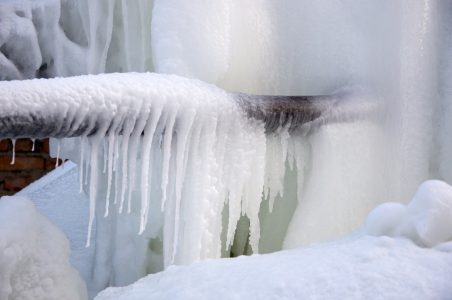How to Avoid Frozen Pipes in Winter: Pro Advice
How to Avoid Frozen Pipes in Winter: Pro Advice
Blog Article
The article in the next paragraphs pertaining to How To Avoid Freezing Pipes is really interesting. Don't miss out on it.

Cold weather can damage your pipes, specifically by freezing pipes. Below's how to prevent it from happening and what to do if it does.
Introduction
As temperatures drop, the risk of frozen pipes increases, potentially causing expensive repair work and water damage. Understanding exactly how to avoid icy pipes is vital for home owners in cool environments.
Avoidance Tips
Protecting susceptible pipes
Wrap pipes in insulation sleeves or make use of warm tape to protect them from freezing temperature levels. Concentrate on pipes in unheated or exterior locations of the home.
Home heating methods
Keep interior areas sufficiently heated, specifically locations with plumbing. Open up cabinet doors to allow warm air to distribute around pipes under sinks.
Exactly how to determine icy pipelines
Try to find lowered water circulation from taps, uncommon smells or sounds from pipes, and visible frost on revealed pipes.
Long-Term Solutions
Structural modifications
Take into consideration rerouting pipes far from exterior wall surfaces or unheated areas. Add additional insulation to attic rooms, basements, and crawl spaces.
Updating insulation
Invest in top notch insulation for pipelines, attics, and walls. Correct insulation aids maintain regular temperature levels and minimizes the risk of icy pipelines.
Safeguarding Outdoor Pipes
Garden tubes and outside faucets
Separate and drain yard hose pipes prior to winter season. Mount frost-proof spigots or cover exterior faucets with protected caps.
Comprehending Icy Pipes
What triggers pipelines to ice up?
Pipes freeze when subjected to temperature levels listed below 32 ° F (0 ° C) for extended periods. As water inside the pipes ices up, it increases, taxing the pipeline wall surfaces and possibly triggering them to break.
Threats and problems
Icy pipelines can lead to supply of water interruptions, property damage, and pricey repairs. Ruptured pipelines can flooding homes and trigger comprehensive structural damage.
Signs of Frozen Pipes
Recognizing icy pipes early can prevent them from breaking.
What to Do If Your Pipelines Freeze
Immediate actions to take
If you believe icy pipes, keep taps available to alleviate stress as the ice thaws. Use a hairdryer or towels taken in hot water to thaw pipelines gradually.
Final thought
Protecting against icy pipes calls for proactive measures and fast reactions. By recognizing the reasons, signs, and safety nets, property owners can secure their plumbing during winter.
6 Proven Ways to Prevent Frozen Pipes and Protect Your Home
Disconnect and Drain Garden Hoses
Before winter arrives, start by disconnecting your garden hoses and draining any remaining water. Close the shut-off valves that supply outdoor hose bibs and leave the outdoor faucet open to allow any residual water to drain. For extra protection, consider using faucet covers throughout the colder months. It’s also important to drain water from any sprinkler supply lines following the manufacturer’s directions.
Insulate Exposed Pipes
Insulating your pipes is an effective way to prevent freezing. Pipe insulation is readily available at home improvement stores and is relatively inexpensive. Pay close attention to pipes in unheated areas such as the attic, basement, crawl spaces, or garage. Apply foam insulation generously to create a buffer against the cold. You can also wrap your pipes in heat tape or thermostat-controlled heat cables for added warmth.
Seal Air Leaks
Inspect your home for any cracks or openings that could let in cold air. Seal any holes around the piping in interior or exterior walls, as well as the sill plates where your home rests on its foundation. Additionally, make sure to keep your garage door closed unless you’re entering or exiting. Leaving it open creates a significant air leak that can lead to frozen pipes.
Allow Warm Air Circulation
During cold snaps, it’s essential to allow warm air to circulate evenly throughout your home. Leave interior doors ajar to promote better airflow. Open kitchen and bathroom cabinets to help distribute heat consistently around the rooms. If you have small children or pets, be sure to remove any household chemicals or potentially harmful cleaners from open cabinets for safety.
Let Faucets Drip
A small trickle of water can make a big difference in preventing ice formation inside your pipes. When temperatures drop significantly, start a drip of water from all faucets served by exposed pipes. This continuous flow helps prevent the water from freezing. Additionally, running a few faucets slightly can relieve pressure inside the pipes, reducing the chances of a rupture if the water inside does freeze.
https://choateshvac.com/6-proven-ways-to-prevent-frozen-pipes-and-protect-your-home/

Do you enjoy more info about Prevent Frozen Pipes ? Write a review down below. We would be happy to know your feelings about this posting. Hoping to see you back again before long. Sharing is caring. Helping others is fun. We thank you for reading our article about Winter Plumbing Precautions: Preventing Frozen Pipes.
Make An Appointment Report this page